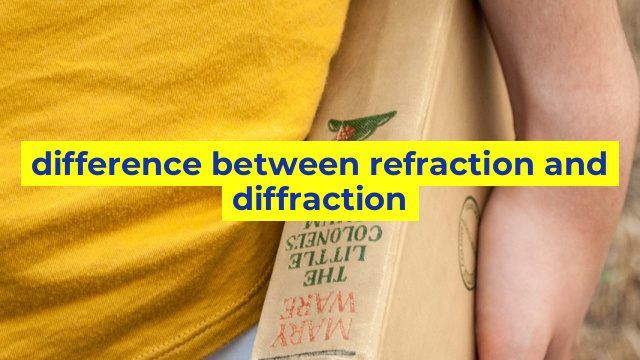The Difference Between Refraction and Diffraction
What is Refraction?
Refraction is the bending of light when it passes through a medium, such as a lens or a prism. The direction of the light wave changes as it passes through the medium, due to the change in its speed. This causes the light to bend and change its direction, as it travels from one medium to another.
The amount of bending depends on the angle of incidence and the refractive index of the medium. Refractive index is a measure of how easily light can travel through a medium, and it is different for each material. For example, the refractive index of water is different from that of air or glass.
What is Diffraction?
Diffraction is the bending of light around an obstacle or through a narrow opening. When light waves encounter a small barrier or aperture, they bend and spread out in different directions. This causes the light waves to diffract and create patterns of light and dark areas.
The amount of diffraction depends on the wavelength of the light and the size of the obstacle or opening. Longer wavelengths diffract more easily than shorter wavelengths, so red light will diffract more than blue light. Similarly, smaller obstacles will diffract light more than larger ones.
The Key Differences between Refraction and Diffraction
The main difference between refraction and diffraction is their causes. Refraction occurs when light passes through a medium with a different refractive index, while diffraction occurs when light waves encounter an obstacle or aperture. Refraction always results in a change in direction of light, while diffraction usually results in spreading of light waves.
Another major difference is the extent to which they affect light waves. Refraction can cause both a change in direction and a change in speed of the light wave, while diffraction only causes a change in the direction of the light wave.
Finally, refraction is used in many applications, including lenses, prisms, and optical fibers, while diffraction is used in the study of light waves and in the construction of diffraction gratings, which are used in spectroscopy and in making holograms.
In conclusion, while both refraction and diffraction involve the bending of light waves, they are caused by different factors and have distinct effects on the behavior of light. Understanding the differences between these two processes can help us better study and utilize the properties of light in a variety of applications.
Table difference between refraction and diffraction
| Refraction | Diffraction |
|---|---|
| Occurs when a wave passes through a medium with a different refractive index, causing the wave’s direction to change. | Occurs when a wave bends around obstacles or passes through openings in obstacles. |
| Occurs when a wave encounters a curved surface, causing the wavefronts to bend. | Can occur with any type of wave, including light, sound, and water waves. |
| The amount of refraction is determined by the refractive index of the media and the angle at which the wave hits the surface. | The amount of diffraction depends on the wavelength of the wave, the size of the obstacle or opening, and the angle at which the wave approaches the obstacle. |
| Commonly observed in lenses, prisms, and mirages. | Commonly observed in phenomena such as the diffraction of light through a narrow slit, the interference patterns of radio waves, and the sound waves around a building. |


